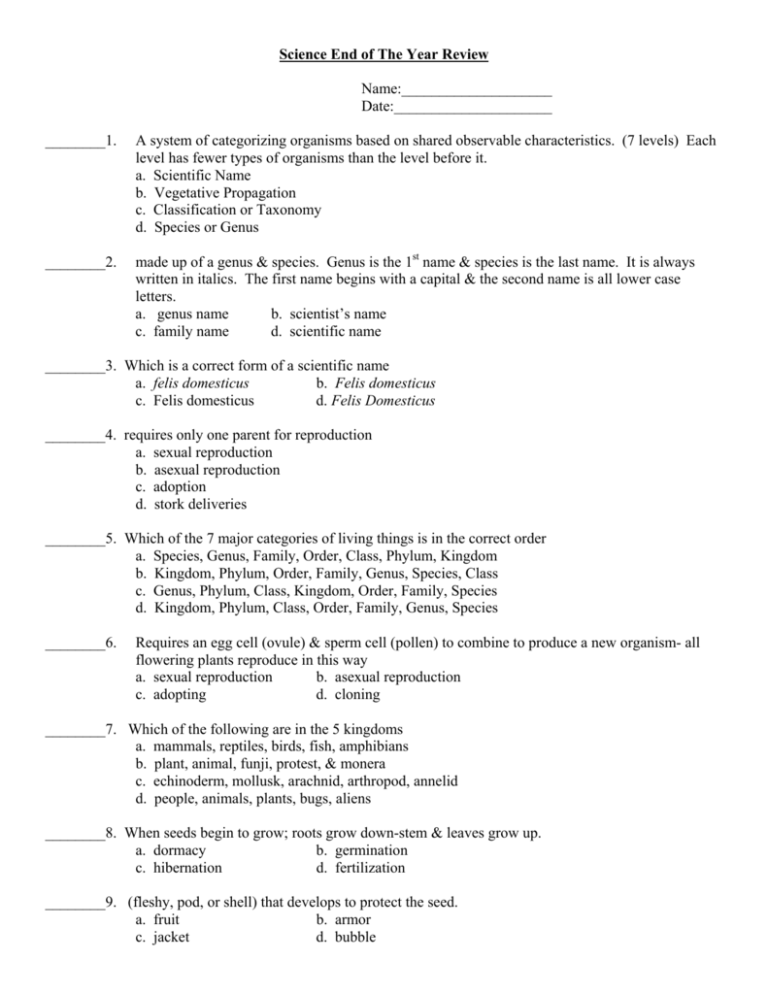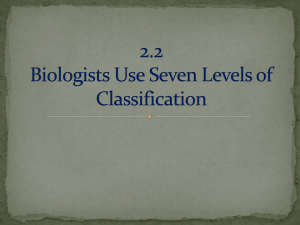End of the Year Review
advertisement

Science End of The Year Review Name:____________________ Date:_____________________ ________1. A system of categorizing organisms based on shared observable characteristics. (7 levels) Each level has fewer types of organisms than the level before it. a. Scientific Name b. Vegetative Propagation c. Classification or Taxonomy d. Species or Genus ________2. made up of a genus & species. Genus is the 1st name & species is the last name. It is always written in italics. The first name begins with a capital & the second name is all lower case letters. a. genus name b. scientist’s name c. family name d. scientific name ________3. Which is a correct form of a scientific name a. felis domesticus b. Felis domesticus c. Felis domesticus d. Felis Domesticus ________4. requires only one parent for reproduction a. sexual reproduction b. asexual reproduction c. adoption d. stork deliveries ________5. Which of the 7 major categories of living things is in the correct order a. Species, Genus, Family, Order, Class, Phylum, Kingdom b. Kingdom, Phylum, Order, Family, Genus, Species, Class c. Genus, Phylum, Class, Kingdom, Order, Family, Species d. Kingdom, Phylum, Class, Order, Family, Genus, Species ________6. Requires an egg cell (ovule) & sperm cell (pollen) to combine to produce a new organism- all flowering plants reproduce in this way a. sexual reproduction b. asexual reproduction c. adopting d. cloning ________7. Which of the following are in the 5 kingdoms a. mammals, reptiles, birds, fish, amphibians b. plant, animal, funji, protest, & monera c. echinoderm, mollusk, arachnid, arthropod, annelid d. people, animals, plants, bugs, aliens ________8. When seeds begin to grow; roots grow down-stem & leaves grow up. a. dormacy b. germination c. hibernation d. fertilization ________9. (fleshy, pod, or shell) that develops to protect the seed. a. fruit b. armor c. jacket d. bubble ________10. Any change that causes a reaction towards light, gravity, touch, temperature, sound, water, space, & food. a. Response b. Tropism c. Gravity d. Stimulus ________11. The way a plant grows or bends to touch. Ex: venus fly trap a. Gravitropism b. Hydrotropism c. Thigmotropism d. Phototropism ________12. When plants loose water through their leaves. a. photosynthesis b. respiration c. transpiration d. fertilization ________13. An inactive period of time when the plant or seed prepares for harsh conditions or change. a. dormancy b. hibernation c. sleep d. tropism ________14. have backbones; are cold-blooded (ectothermic); can breathe in water with gills early in life, and breathe on land with lungs as adults; go through metamorphosis; lay jelly-like eggs. Examples are frogs, toads, and salamanders. a. annelid b. mollusk c. amphibian d. reptile ________15. This adaptation is for fluid-feeders. Examples are mosquitoes, aphids, or hummingbirds. a. tube shaped mouth b. stingers c. different shaped beaks d. expandable stomachs ________16. Which group of animals are all endothermic? a. penguin, horse, cat, dog b. fish, penguin, lizard c. snake, pig, elephant d. ladybug, people, jellyfish, worm ________17. Which group of animals are all vertebrates? a. fish, annelids, reptiles, birds, mammals b. mollusk, sponges, annelids, arthropods, echinoderms c. fish, amphibians, reptiles, birds, mammals d. echinoderms, amphibians, reptiles, birds, mammals ________18. have backbones; are cold-blooded (ectothermic); obtain dissolved oxygen in water through gills; most lay eggs; have scales; have fins; and live in water a. fish b. amphibians c. reptiles d. birds ________19. are very simple animals that have many pores (holes) through which water flows. Water moves into a central cavity and out through a hole in the top. They obtain their food and eliminate wastes through this passage of water. They live in fresh or salt water. a. mollusk b. annelid c. sponge d. amphibian ________20. have similar parts (arms) that extend from the middle body outwards. They have tube feet and spines. Examples are starfish, brittle stars, sand dollar, sea cucumbers, or sea urchins. a. reptile b. mammal c. echinoderm d. arthropod ________21. Special features that enable an animal to survive in its environment are called a. migration b. hibernation c. classification d. adaptation ________22. Atlantic green turtles travel to Ascension Island. This is an example of a. hibernation b. migration c. defense d. transpiration ________23. When animals go under rocks, leaves, logs, deep into water, or bury themselves into mud during cold weather…this is an example of a. defense b. hibernation c. migration d. transpiration ________24. Behaviors that were taught to the animal, often by its parent a. learned behavior b. behavior c. instinct d. response ________25. Traits that the animal is born with-no one had to teach them. ex: migration a. learned behavior b. instinct c. behavior d. response ________26. Plants use __________energy from the sun. a. solar b. electrical c. heat d. mechanical ________27. Water behind a dam has stored energy called a. kinetic b. potential c. solar d. chemical ________28. A curling iron uses __________ energy from an outlet to create heat energy. a. heat b. chemical c. electrical d. solar ________29. __________ energy is the energy of motion. a. kinetic b. nuclear c. wind d. potential ________30. Batteries use stored energy. When they are used, they can turn a toy into _______ energy. a. solar b. chemical c. electrical d. mechanical ________31. Plants use energy from the sun & store it as __________ energy through photosynthesis a. solar b. chemical c. electrical d. mechanical ________32. The _____________ states that energy cannot be changed, created, destroyed, lost, or gained. It is merely transformed. a. Law of Making Energy b. Newton’s Law of Relativity c. Electrical Energy Law d. Law of Conservation of Energy ________33. _________ energy provides heat and light energy for Earth. a. light b. heat c. solar d. thermal ________34. What energy conversions occur when you turn on the lights in your house? a. mechanical-solar-heat b. electrical-light-heat c. chemical-mechanical-heat d. nuclear-heat-light ________35. An _____________ is a temporary magnet that can be turned on and off. a. Horse shoe magnet c. refrigerator magnet b. Electric magnet d. electromagnet ________36. An object must ______in order for work to be done. a. be warm b. be cold c. move d. sweat ________37. The ____________is the point where the lever arm pivots. a. load b. lever c. fulcrum d. effort _______38. A _____ is a simple machine that people use to gain a mechanical advantage, such as making work easier. a. load b. lever c. fulcrum d. effort ________39. A _____ is a like a lever except that it has a grooved wheel with a rope running along the groove. a. lever b. fulcrum c. inclined plane d. pulley ________40. A ________is a device that makes doing work easier by reducing the amount of force required to move an object. a. moving man b. complex machine c. thing a ma bob d. simple machine ________41. An ___________is a sloping surface like a ramp that reduces the amount of force required to move an object. a. lever b. fulcrum c. inclined plane d. pulley ________42. Which technological advancement has done the most to improve the accuracy of weather predications? a. barometer b. weather balloons c. anemometer d. satellites ________43. Paxton wants to measure the amount of rain falls in his backyard during a thunderstorm. Which instrument should he use? a. Radar b. Thermometer c. Rain gauge d. Barometer ________44. As the air warms, the liquid in this instrument expands and rises. What weather instrument does this describe? a. Weather vane b. Weather balloon c. Spring scale d. Thermometer ________45. What does a weather vane measure? a. Speed of the wind b. Direction of the wind c. Temperature of the wind d. If there will be wind tomorrow ________46. When a meteorologist reports that the air pressure is falling in your area, what instrument did she probably use to get this information? a. A barometer b. A thermometer c. A sling psychrometer d. An anemometer ________47. Wind is formed by _______. a. Earth’s tilt on its axis b. The uneven heating of Earth’s surface by the Sun c. The gravitational pull of the Sun and the Moon d. The revolution of Earth around the Sun ________48. _______, a fast-moving ribbon of air that moves around the globe of Earth, are important because weather systems move along their paths. a. Ocean currents b. Warm fronts c. Jet Streams d. Sea breezes ________49. The _______ move weather systems in the United Sates from west to east. a. Trade Winds b. Land breezes c. Westerlies d. Polar Easterlies ________50. Which global wind system has the greatest effect on weather patterns in the United States? a. Doldrums b. Prevailing westerlies c. Polar easterlies d. Trade winds Extra Credit ________1. Because warm air near Earth’s surface rises and then cools as it goes up, a ______is set up in the atmosphere. a. convection current b. greenhouse effect c. surface current d. water current ________2. Convection currents near bodies of water can cause local winds known as a. greenhouse effect b. climate zones c. Coriolis Effect d. land and sea breezes _________3. Karen climbs the stairs in her house on a summer day and notices that it is much hotter upstairs than downstairs. What is the best explanation for this? a. Warm air moves upward by convection currents. b. The upstairs is closer to the sun. c. The downstairs windows were left open. d. Cool air rises by convection currents. _________4. Which statement is true? a. A sea breeze flows from the ocean toward the land at night due to uniform heating and cooling of land and ocean. b. A sea breeze flows from the land toward the ocean at night due to uniform heating and cooling of land and ocean c. A sea breeze forms at night due to the ocean cooling faster than the land. d. A sea breeze forms during the day due to the land warming faster than the ocean ________5. My favorite unit of study this year was a. plants b. animals c. weather d. simple machines








